
Skin allergies are a common health issue faced by pets, causing a lot of discomfort and distress for both the pet and for the pet parent (especially when they are scratching like crazy at 2 a.m.).
There are many factors that can contribute to skin allergies in pets, including environmental factors, fleas, foods, and genetics. In this blog post, you will learn the most 4 most common allergies in dogs and cats, the symptoms, causes, treatment options, and how to prevent allergies from ruining you and your pet’s life. Atopic Dermatitis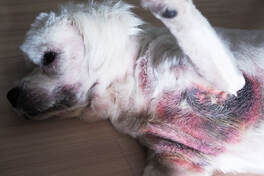
Atopic dermatitis, or atopy, is a type of skin allergy caused by pets having reactions to normally innocuous environmental substances such as pollen, mold, insect particles, and dust mites. Atopic dermatitis is considered to be both an immune hypersensitivity issue (they are reacting to things they shouldn’t) and a structural skin barrier problem (things are getting through the skin layers that shouldn’t). While humans have sneezing and runny eyes, dogs and cats get itchy skin (and sometimes sneezing and runny eyes too).
This type of skin allergy is inheritable in dogs (in cats we aren’t sure), and while it is more common in certain breeds of dogs, including Boston terrier, boxer, cairn terrier, Chinese shar-Pei, cocker spaniel, Dalmatian, English bulldog, setters, pit bulls, Frenchies, Lhasa Apso, miniature schnauzer, pug, Westies, labs, and goldens, it can be seen in any dog. Additional facts about atopic dermatitis:

Symptoms of Atopic Dermatitis
Atopic dermatitis causes itching, skin irritation, hair loss, and redness. In dogs, it can cause nail bed infections. Cats develop bumps all over their body, called miliary dermatitis. Secondary problems, including hot spots and skin and ear infections, as well as itchy, runny eyes and sneezing, are common. How is Atopic Dermatitis Diagnosed? A veterinarian uses a combination of oral history from you, physical exam, and skin testing to rule out other issues, like skin infections or mites, to diagnose atopic dermatitis. This is also true of diagnosing other skin conditions including all allergies covered in this article as well. How is Atopic Dermatitis Treated? OTC medications that are used to manage (not cure) the disease by controlling itching include:
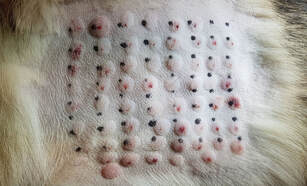 Intradermal skin testing Intradermal skin testing
Once your pet has been diagnosed with atopy, then some vets may offer a blood test to determine what your pet is allergic to. The blood test measures the amount of IgE antibody in your pet’s blood.
Pros of the blood test include:
These tests can be helpful, but they do have their limitations:
While regular vets can provide relief from itching and blood allergy tests, If you really want to know what your pet is allergic to, then you need to take your pet to a veterinary dermatologist for intradermal skin testing. Blood tests are more convenient, but the diagnosis is not as accurate as skin testing. Skin testing is more expensive and requires sedation, but:
How to Prevent Atopic Dermatitis The only way to prevent symptoms other than allergy shots is to avoid the allergens and use medicated products. If your dog is allergic to pollen, then keeping them inside when pollen counts are high or wiping them off with a wipe after they go outside (especially their paws, underbelly, and any skin folds/wrinkles) is a good start. If they roll in the grass, wipe their whole body! I like HICC Pet wipes because the hypochlorous acid is stabilized (very important!) and clinically proven to be anti-inflammatory, pro-skin health, and anti-itch. As an aside, it also kills COVID. Who knew. Additional preventive measures include:
These therapies work best when you are proactive - if you know that your pet has allergies to pollen or during a certain time of the year, for example, then starting antihistamines and wiping them off BEFORE they start to show symptoms. Flea Allergy Dermatitis
Did you know that dogs and cats can be allergic to flea saliva? It’s true! In pets that are allergic, the bite of just one flea can drive them crazy enough to pull their hair out! This type of skin allergy is moderately common in pets and can cause intense itching, redness, and skin irritation. Flea allergy dermatitis can lead to further complications such as hot spots (raw wounds where the pet has pulled out their hair) and secondary bacterial infections. Flea allergy dermatitis is a seasonal problem unless you live in an area where fleas are present year round. In which case, god bless you.
Symptoms of Flea Allergy Dermatitis In dogs, flea allergy dermatitis usually manifests as a raw, oozing, hairless, intensely itch wound on the neck or around the base of the tail. In cats, flea allergy dermatitis usually manifests as bumps all over the body (called miliary dermatitis) and/or hot spots around the head and neck. Treatment of Flea Allergy Dermatitis Treatment typically includes shaving and cleaning the hot spot, steroids to stop the itch, and antibiotics for skin infections. Prevention of Flea Allergy Dermatitis Prevention of fleas is critical to prevent flea allergy dermatitis, and vets will typically recommend an insect growth regulator (like Interceptor) to keep fleas from maturing and a quick-kill prescription flea prevention to prevent flea allergy dermatitis. In addition:
Contact Dermatitis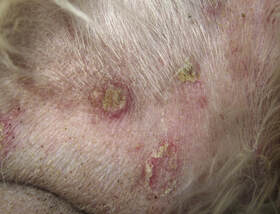 Bacterial Skin Infection Bacterial Skin Infection
Contact dermatitis is a type of skin allergy caused by exposure to certain irritants such as chemicals, plants, and metals. It is different from atopy in that only the part of the body that touches the offending substance is itching or red. Dogs can develop contact dermatitis from exposure to things like pesticides, cleaning products, laundry detergent, and certain plants.
Symptoms of Contact Dermatitis Contact dermatitis usually causes localized skin irritation, itching, and redness, and can lead to further complications such as hot spots and secondary infections. It is often seen on the belly or paws. Treatment of Contact Dermatitis Treatment includes medications to stop the itch and treatment of any secondary infections. It also helps to give these animals a bath. Prevention of Contact Dermatitis You can prevent contact dermatitis by identifying what your pet is allergic to, and then avoiding exposing your pet to that substance. Try switching to a hypoallergenic, fragrance free laundry detergent and only use hypoallergenic shampoos on your pet. If your pet has chin acne, switch to a stainless steel bowl and wash the bowl daily in between feedings. Food Allergies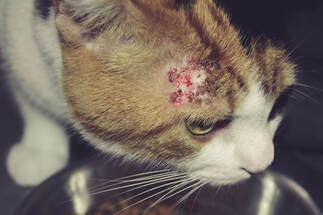
Food allergies, otherwise known as cutaneous adverse food reactions, are a type of skin allergy caused by an allergic reaction to certain proteins found in food. Common allergens in pet food include beef, chicken, dairy, egg, pork, and soy. Wheat and corn allergies are much less common. Pets are usually fed the offending food for at least 2 years before developing symptoms.
Symptoms of Food Allergies Symptoms of food allergies occur after the pet has eaten something they are allergic to. Symptoms are often year round (if the pet is eating the same food year round). It is the third most common allergy in dogs and the second most common allergy in cats. All dog breeds are susceptible, in cats food allergies are more common in Siamese cats. Food allergies can cause skin irritation, itching, and redness, and can lead to further complications such as hot spots and secondary infections. In contrast to flea allergies and atopic dermatitis, food allergy patients often have concurrent gastrointestinal signs, including excessive gut sounds, gas, frequent bowel movements, vomiting and diarrhea. Diagnosis and Treatment of Food Allergies Unfortunately, there is no accurate test in veterinary medicine to diagnose food allergies - so don’t waste your time on those tests you can buy on the internet! Diagnosis of food allergies is a diagnosis of exclusion, meaning the vet has to rule out other causes before assuming a food allergy. The only way to diagnose a food allergy is by removing allergens from your pet’s diet and seeing if the symptoms resolve. This is either done by feeding the pet a novel protein food (something they have never eaten before) or feeding them a hypoallergenic food (usually prescription only) that has hydrolyzed proteins that have had the allergens removed. Now…most people think they can just switch their pet to a different kind of food with different ingredients, but unfortunately it just ain’t that simple. Most, if not all, commercial pet foods are made in factories that make multiple types of food on the same machines. If the machines aren’t completely, 100%, ridiculously meticulously cleaned in between food runs (which they aren’t) then the food is ‘contaminated’ with microscopic particles of ingredients from other diets. For example - if you think your dog might be allergic to chicken so you switch to a lamb formula, that lamb food is likely made on the same rollers as chicken food, and contains microscopic chicken particles, even though it doesn’t say chicken on the bag. Normally, this isn’t a problem. For food allergic pets, it is. This is why your vet wants you to purchase and feed your pet a therapeutic diet that is made on entirely cleaned/dedicated machinery to ensure there are no microscopic contaminants from potential allergic ingredients. (ps this is also why the food is so expensive) Most feeding trials last anywhere from 8-10 weeks, depending on how fast symptoms resolve (or not). During this feeding trial your pet cannot eat ANYTHING ELSE, including people food, treats, or flavored medications (including heartworm prevention - to ask your vet for unflavored heartworm prevention during this time). If your pet accidentally consumes something other than the prescribed food, then the diet trial starts over. Wah wah. The reason the feeding trial is so long is it takes that long for skin and gut cells to turnover. If your pet has a food allergy, then they will likely have resolution of gastrointestinal signs first (because those cells turnover faster, usually 2-4 weeks) and resolution of skin signs second (usually takes 6-8 weeks). If all signs resolve, then great! Your pet likely has a food allergy and you have two options:
Most pet parents don’t want symptoms to return and elect to stay on the special food. Prevention of Food Allergies Easy: don’t feed your pet the offending ingredient(s). Skin allergies are a common problem for dogs, causing a range of symptoms from mild irritation to serious health issues. Understanding the causes, symptoms, and treatment options for each type of skin allergy is important for managing the condition and providing relief for the dog's symptoms. It’s also important to remember that not all itchy pets have allergies - the problem might be something else entirely. This is why it is important to involve your favorite veterinarian in diagnosing the problem before you start treating. By identifying and managing the underlying cause of itching, pet parents can help prevent further complications and ensure the overall health and well-being of their furry companions. xoxo Dr. Sarah Wooten Recommended Skin Care and Nutrition Products:
0 Comments
|
AuthorDr. Sarah Wooten is a well known international influencer in the veterinary and animal health care spaces. She has 16 years experience in private practice and over 10 years experience in veterinary media work, and is a certified veterinary journalist. Archives
October 2023
Categories |
The information provided by Sarah J. Wooten, DVM, Inc. (https://www.drsarahwooten.com/ (the our mobile application our mobile application our mobile application THE SITE OR OUR MOBILE APPLICATION THE SITE AND OUR MOBILE APPLICATION THE SITE AND OUR MOBILE APPLICATION THE SITE AND OUR MOBILE APPLICATION
AFFILIATES DISCLAIMER
Clickbank
ShareASale
We are a participant in the Amazon Services LLC Associates Program, an affiliate advertising program designed to provide a means for us to earn advertising fees by linking to Amazon.com and affiliated websites.
TESTIMONIALS DISCLAIMER
The Site may contain testimonials by users of our products and/or services. These testimonials reflect the real-life experiences and opinions of such users. However, the experiences are personal to those particular users, and may not necessarily be representative of all users of our products and/or services. We do not claim, and you should not assume, that all users will have the same experiences. YOUR INDIVIDUAL RESULTS MAY VARY.
The testimonials on the Site are submitted in various forms such as text, audio and/or video, and are reviewed by us before being posted. They appear on the Site verbatim as given by the users, except for the correction of grammar or typing errors. Some testimonials may have been shortened for the sake of brevity where the full testimonial contained extraneous information not relevant to the general public.
The views and opinions contained in the testimonials belong solely to the individual user and do not reflect our views and opinions. We are not affiliated with users who provide testimonials, and users are not paid or otherwise compensated for their testimonials.
The testimonials on the Site are not intended, nor should
they be construed, as claims that our products and/or services can be used to
diagnose, treat, mitigate, cure, prevent, or otherwise be used for any disease
or medical condition. No testimonials have been clinically proven or evaluated.
This disclaimer was created using Termly's Disclaimer Generator.


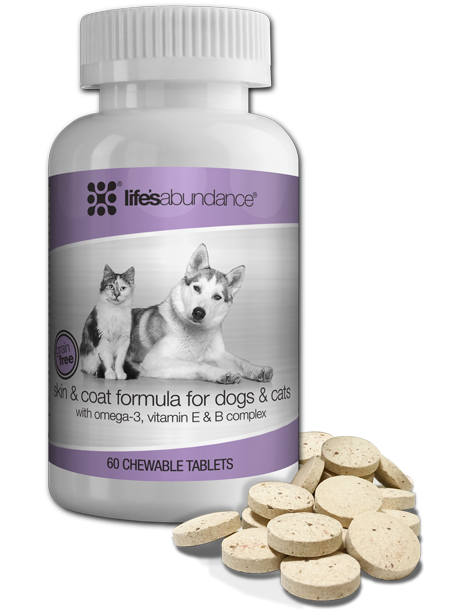
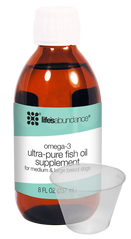



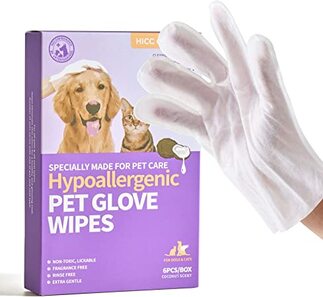
 RSS Feed
RSS Feed